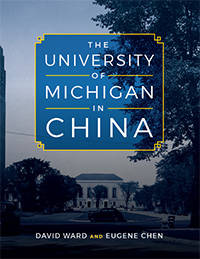
The University of Michigan in China
Skip other details (including permanent urls, DOI, citation information): This work is licensed under a Creative Commons Attribution-NonCommercial-NoDerivatives 3.0 License. Please contact [email protected] to use this work in a way not covered by the license.
For more information, read Michigan Publishing's access and usage policy.
1. Introduction
The story of the University of Michigan (U-M) is the story of a university growing beyond state and national borders, of a university leading the American public in reaching out to other nations. Nowhere is this more visible than with China. The relationship between U-M and China reaches back more than a century and a half to the first years of the Ann Arbor campus and the last years of the Qing dynasty.
It was an era of contention between the East and the West: in China, the violence of the Opium Wars and the political exploitation that followed led to a mistrust of foreigners with imperialist inclinations; in America, economic hardship following the Civil War led to an increasing resentment of Chinese immigrants. The University of Michigan forged an alliance with China that ran counter to public sentiment on both sides. From Judson Collins, a member of U-M’s first graduating class, who became a missionary in the city of Fuzhou, to James Angell, U-M’s longest-serving president, who became a diplomat in Beijing and a voice of reason in the contentious immigration debate, to Kang Cheng and Shi Meiyu, U-M’s first Chinese students, the latter half of the 19th century saw U-M initiate a partnership with China that replaced tension and distrust with education and good works.
The start of the 20th century followed through on this partnership. Encouraged by Angell, the return of the Boxer indemnity in the form of a scholarship fund for Chinese students studying in America meant that the number of Chinese students at the University of Michigan rose dramatically. And the Barbour Scholarship, endowed in 1917 by U-M regent Levi Barbour, meant that Chinese women had a new, crucial avenue to higher education. Graduates like Ding Maoying, John C. H. Wu, and Wu Dayou exemplify the importance of education at U-M during these years. Ding Maoying leapt straight from her medical degree to a position at the head of a hospital in Tianjin; John C. H. Wu, building on the foundation of his U-M law degree, drafted the Republic of China’s constitution; and Wu Dayou shaped the study of physics in both China and Taiwan.
The University of Michigan was with China during the war years. American graduates Robert Brown and Tom Harmon served in China as a doctor and an air force pilot supporting the Flying Tigers, respectively. Wu Yifang, a Barbour Scholar, became China’s first female college president just in time to shepherd Jinling (Ginling) College through some of China’s most difficult years. And although relations between the United States and China cooled with the Korean War, graduates from the University of Michigan played crucial roles in establishing the new People’s Republic of China (PRC). Zhu Guangya helped orchestrate the PRC’s burgeoning nuclear weapons program; Zeng Chengkui jump-started the discipline of marine botany, and his techniques for farming algae fed many people as famine loomed; and Huang Jiasi rose to the top of the leadership in the PRC’s new medical institutions.
When it came time for rapprochement between the two countries, the University of Michigan was there, hosting the Chinese table tennis team and organizing the “return volley” of the ping-pong diplomacy that thawed relations between the People’s Republic and the United States.
Now in the early years of the 21st century, the University of Michigan and China are old friends. There are more students from China at U-M than from any other foreign country. In departments all over the University, scholarship and travel programs, research collaborations, joint degree programs, and joint institutes spring up left and right. As it has ever been, U-M is not beholden to political trends or public sentiments. The benefits of friendship and the fruits of collaboration are too clear.
The story of the University of Michigan’s friendship with China is the story of astonishing individuals. There are many “firsts” in this book—first female college president, first woman with a PhD in physics—and there are many “fathers” of disciplines. While much has been written separately about these leaders and scholars, in both English and Chinese, nowhere is their collective story told or their shared bond with U-M celebrated. It is the aim of this book, as a gift from the U-M Association of Chinese Professors, to celebrate this almost 200-year-old legacy.
Such is the wealth of China’s contribution to the University of Michigan and the University’s contributions to China that this book can only contain the smallest fragment of the stories worth telling. There are hundreds of Barbour Scholars not included in this book. There are whole schools at U-M whose history with China is yet untouched. The Ford School of Public Policy, for example, benefited from an influx of Chinese students in the early years of the 20th century, including Chen Yeyi, who became China’s only female general during the Sino-Japanese War. And there are just as many American students and faculty who spent time in China during these years, such as Harry Bouchard, a civil engineer who taught in Tianjin.
There have been an extraordinary number of Chinese graduates from the University of Michigan in the last four decades. Their stories, and the story of U-M’s continuing relationship with China, will—we hope—be told in future books. There is enough here to fill volumes.


